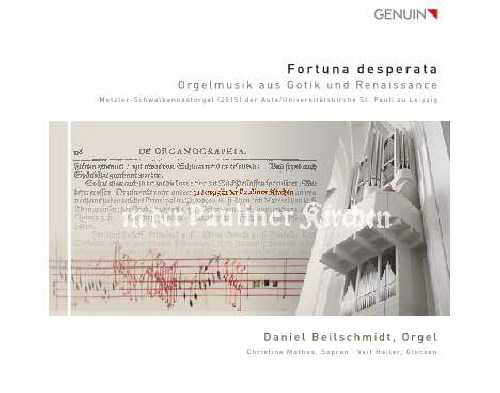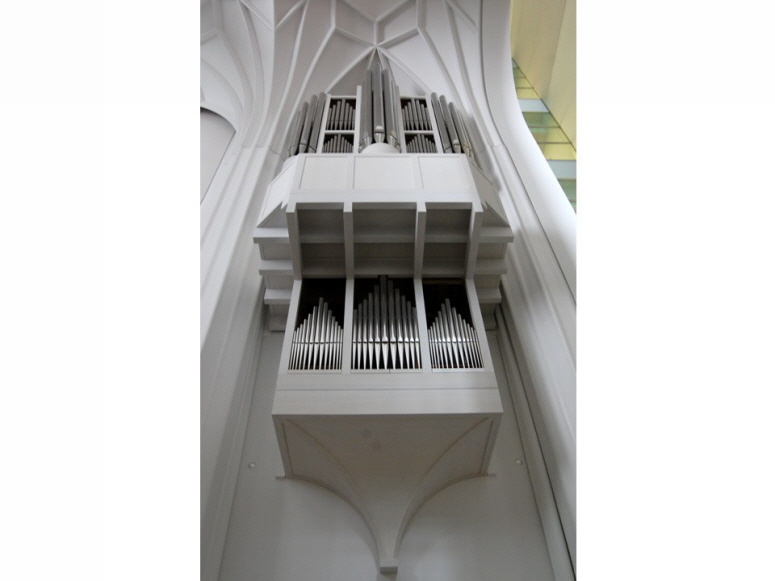Fortuna desparata
Organ music of Gothic and Renaissance
First CD recording of the Swallow´s Nest Organ in the New Assembly Hall and University Church of St Paul in Leipzig.
Information about how to order and purchase the CD for 18,90 € each will be provided individually by sending an email to info(at)stiftung-universitaetskirche.de. Please buy the CD from us. The proceeds of CD sales made by the Foundation will go to the Foundation´s own projects.

Performers:
Daniel Beilschmidt, organ
Christine Mothes, soprano
Veit Heller, hand bells
Commissioned by University of Leipzig University Music
Idea and funding by the Foundation ´University Church of St Paul, Leipzig´
Titles:
Buxheimer Orgelbuch (~ 1470)
Redeuntes in idem (Ut) mp3
Guillaume de Machaut (1300 – 1377)
Sanctus (Messe de Nostre Dame) mp3
Robertsbridge Codex/Philippe de Vitry (~ 1320)
Adesto – Firmissime fidem teneamus – Alleluia
Tabulatur des Adam Ileborgh von Stendal (1448)
Sequitur aliud praeambulum super d manualiter et variatur super a g f et c
Codex Faenza 117 (~ 1380 – 1420)
Kyrie Cunctipotens Genitor Deus
Gloria Cunctipotens Genitor Deus mp3
Tabulatur des Adam Ileborgh von Stendal (1448)
Praeambulum super d a f et g
Sequitur mensura sex notarum eiusdem tenoris
Frowe al myn hoffen an dyr lyed
Incipit Fortuna
Antoine Busnois(?) (1430 – 1492)
Fortuna desparata mp3
Johannes Buchner (1483 – 1538)
Fortuna in fa trium vocum, Tenor in Basso
Tabulatur des Leonhard Kleber (1495 – 1556)
Fortuna in fa quatuor vocum
Fortuna in mi
Antoine Busnois/Alexander Agricola(~ 1446 – 1506)
Fortuna desparata à 6
Paul Hofhaimer (1459 – 1537)
Salve Regina
Tabulatur des Adam Ileborgh von Stendal (1448)
Sequitur praeambulum in C et potest variari in d f g a
Johannes Buchner
Dantz Moss. Benczenauer
Buxheimer Orgelbuch
Redeuntes in mi
St. Galler Orgelbuch/Heinrich Isaac (~ 1450 - 1517)
Tota pulchra es
Johannes Buchner
Christ ist erstanden
Sethus Calvisius (1556 – 1615)
Christ ist erstanden
St. Galler Orgelbuch
Christ ist erstanden
Total running time 77´22
Swallow´s Nest Organ of the University Church of St Paul
This recording marking the arrival of a new organ celebrates not only the organ itself, but also the discovery of the multi-coloured and extensive organ repertoire from the 14th to the early 16th century. Built in the style of a late-Gothic and Renaissance instrument, the Metzler organ of the University of Leipzig offers sounds that have not been experienced for centuries.
Support for the idea to add to the Jehmlich organ on the west gallery a second instrument in the choir of the Assembly Hall and University Church of St Paul is found in a historical record of the university organ. This second instrument is unique to the musical tradition of the city of Leipzig and Central Germany. The famous seventeenth-century composer, musicologist and organ specialist Michael Praetorius describes the organ in St Paul´s in the second volume of his Syntagma Musicum (1619) as an instrument characterised by the transition from the late medieval Blockwerk to the Renaissance instruments with Rückpositiv which offered a greater diversity of sound. The specification listed there is the inspiration for the Swallow´s Nest Organ (Praetorius describes it as ´soaring at a great height´). The specification mentioned by Praetorius in the Syntagma Musicum was not only the basis for the project, but it is also the only historical reference for it. By the 18th century, nothing was left of the original instrument. Thus there was nothing that could have served as a starting point for a detailed reconstruction, nor were there any extant drawings of the casework. It can be said for certain that the organ, built by the Swiss Metzler Orgelbau AG, differs from the one described by Praetorius in terms of its place and structure. Previously located on the wall of the north side, the modern instrument is suspended flat and high up in front of the third pillar yoke in the quire. The Rückpositiv described by Praetorius is immediately behind the organist and speaks into the room, yet, it is now hanging as an Unterwerk beneath the console and elegantly finished with a cone, a so-called ´Cul de Lampe´. Due to the epitaphs salvaged before the destruction of the Old University Church, which are now suspended between the pillars of the quire, it was necessary to keep the depth of the space used for organ as small as possible. Otherwise the Rückpositiv would have been too close to the epitaphs, which would have been detrimental to the sound. The Swallow´s Nest Organ is therefore not a replica but rather an instrument inspired by the style of the period and based on the latest scholarship about early organ building.
Due to funding being only available in stages, the current disposition is that of a late-15th-century instrument with seven playable stops. With the Grossprincipal 16´, Principal 8´, Octava 4´and the 7-12-fold Mixture in the Oberwerk, the largest principal plenum offers a strong and bright sound that is typical of Gothic Blockwerk organs. Thanks to the coupling, the first two stops can also be played individually using the pedals. Moreover, there is one representative each of the tender flutes and the jarring reed family. The Principal 4´ in the Unterwerk makes it possible to use the lower manual, however as a single stop.The Tremulant offers the possibility of adding a light vibrato to the organ tone for lyrical pieces. The Birdsong (Vogelsang) enables the creation of amusing effects. This means that the organ can produce a range of tonal colours. The goal of the second building phase is to achieve the tonal variety of the Renaissance and Early Baroque organ, with principal stops, flute stops, reed stops, aliquot stops, mixtures and effects.
It is a great honour for the Foundation ´University Church of St Paul, Leipzig´to have raised more than 195.000 € for the construction of the Swallow´s Nest Organ of the University Church. Benefit concerts under auspices of Saxony´s State Minister Stanislaw Tillich as well as a financial contribution from the City of Leipzig were the basis for drawing attention to the project, ensuring that the university could commission the first stage of building the Renaissance organ that is unique in Central Germany.
The foundation is indebted to University Organist Daniel Beilschmidt for the realisation of the idea of a first recording from the New Assembly Hall and University Church St Paul. The threefold ´Christ is risen´at the end of the recording expresses our joyful hope that the location of the old University Church, destroyed on 30 May 1968, will soon once again be a place of worship.
With the CD, the foundation would like to appeal the completion of the magnificent swallow´s nest organ! The promotors have set up the following bank account for donations:
BIC: HYVEDEMM495


 Print
Print